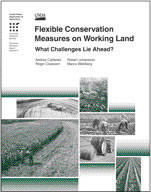Flexible Conservation Measures on Working Land
- by Andrea Cattaneo, Roger Claassen, Robert Johansson and Marca Weinberg
- 6/3/2005
Overview
The 2002 Farm Bill sharply increased conservation funding and earmarked most of the increase for working-land payment programs (WLPPs). The design and implementation of WLPPs will largely determine the extent to which environmental goals are achieved and whether they are achieved cost effectively. This report simulates potential environmental gains as well as adjustments in agricultural production, price, and income associated with various WLPP features to illustrate tradeoffs arising from WLPP design and implementation.
Download
-
Entire report
Download PDF -
Report summary
Download PDF -
Abstract, Acknowledgments, Contents, and Summary
Download PDF -
Chapter 1: Setting the Stage
Download PDF -
Chapter 2: Designing Voluntary Incentive Payments for Working Land Conservation
Download PDF -
Chapter 3: Economic and Environmental Impacts of WLPPs
Download PDF -
Chapter 4: WLPPs in a Broader Policy and Economic Context
Download PDF -
References
Download PDF -
Appendix: Participation Incentives and Screening: A Graphical Analysis
Download PDF -
Web Appendix A: Simulating Working-Land Payment Programs
Download PDF -
Web Appendix B: Aggregate Environmental Indices
Download PDF -
Web Appendix C: Conservation Benefits, Installation Costs, and Land Rental Rates
Download PDF

